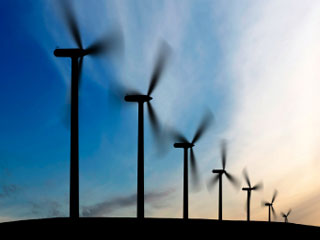|
Overhauling our Nation’s Energy Policy On December 13, 2007, the Senate passed a landmark Energy Bill (H.R. 6) that raises fuel economy standards for the first time in 30 years. It also establishes an aggressive renewable fuel standard that will help make our country self-reliant on American-grown biofuels. These measures will save Nevadans over $170 million each year, create jobs, and help protect our economy from oil price shocks. The 2007 Energy Bill is just one of many important steps we must take forge a clean energy revolution. Under my leadership, the Senate recently took another critical step by passing legislation, the Emergency Economic Stabilization Act of 2008 (EESA), which was signed into law in early October 2008, that extends and expands much needed tax credits for renewable energy and energy efficiency. For the most up to date listing of these important incentives and their benefits please click here or here.
Supporting Renewable Energy in Nevada and Across America Our nation’s security and environment rests on our ability to access renewable energy resources, and to invest in greater energy efficiency. To ensure that this important conversation remains prominent, the National Clean Energy Summit’s website has been updated to include the summit’s highlights. Nevada has the potential to be the nation’s renewable energy epicenter. In fact, I strongly believe that Nevada can become a net exporter of renewable power with the right partnership between federal and state government and the private sector. Southern Nevada’s abundance of clear sunny days make it one of the best locations for solar energy in the world, and northern Nevada holds the largest amount of untapped geothermal resources in the United States. There are also tremendous wind resources throughout the state. That is why I have consistently supported a national renewable electricity standard, as well as fair and stable federal tax incentives for development of clean energy resources, like geothermal, solar, and wind. I have worked hard to add geothermal energy to the list of renewable energy projects eligible for the renewable energy production tax credit and loan guarantees. Accessing Our State’s Renewable Energy Resources Delivering Renewable Power to Nevadans through Transmission Some of Nevada’s best renewable energy resources are located in rural areas where access to transmission lines is sorely lacking. Upgrading transmission lines in these energy rich locations will create jobs and can power towns and cities throughout our great state. Transmission lines linking northern Nevada with southern Nevada must be built so that we can fully reap the benefits of our abundant renewable energy resources, improve the reliability of the grid, and make energy use more efficient and affordable. Efficiency and Conservation Nevadans have been paying record high prices for electricity, and could face additional rate hikes in the near future. Energy efficient homes and buildings reduce the demand for electricity at the utility level and reduce the need for utilities, especially in southern Nevada, to buy expensive out-of-state power to meet peak power needs. Energy efficiency and conservation are practical and cost effective – they have the potential to reduce entire U.S. energy demand by 14 to 19 percent by 2020 without costing a dime in the long run. For consumers hardest hit by increasingly expensive energy, Congress has acted several times in recent years to put additional funds into the weatherization program to help people make their homes more energy efficient, as well as the low-income home energy assistance program that helps people pay their bills when times are tough. The 2007 Energy Bill improves efficiency and reduces energy consumption through improved standards for federal and commercial buildings, as well as appliances and lighting. Consumer appliances, like dishwashers, washing machines, refrigerators and freezers will now use less electricity and reduce energy costs. New buildings will have to use less energy, following the federal government’s lead with a new zero net energy initiative for federal buildings. The recently passed Emergency Economic Stabilization Act of 2008 also extends tax credits for energy efficient appliances, homes and buildings, and expands incentives for consumer’s purchasing plug-in electric drive vehicles. Opposing New Coal Plants in Nevada You can find more information about why coal power is not right for Nevada in the following reports:
Maps: Geothermal, Solar, Wind or Biomass Energy Independence – Investing in a Secure Future Nevada State Office of Energy Nevada Renewable Energy and Conservation Task Force Energy Information Administration: Nevada Profile Nevada Energy Connection Related Press Releases
|
RenoBruce R. ThompsonCourthouse & Federal Bldg 400 S. Virginia St, Suite 902 Reno, NV 89501 Phone: 775-686-5750 Fax: 775-686-5757 |
Washington DC528 Hart Senate Office BldgWashington, DC 20510 Phone: 202-224-3542 Fax: 202-224-7327 Toll Free for Nevadans: 1-866-SEN-REID (736-7343) |
Carson City600 East William St, #302Carson City, NV 89701 Phone: 775-882-REID (7343) Fax: 775-883-1980 |
Las VegasLloyd D. George Building333 Las Vegas Boulevard South, Suite 8016 Las Vegas, NV 89101 Phone: 702-388-5020 Fax: 702-388-5030 |
 I was pleased to help ensure the legislation included long-term extensions of the solar investment tax credit and eliminated the previous cap on that credit for residential solar electric systems. These kind of incentives are imperative for our protecting our economic, energy and national security. They help businesses and consumers tap into the American innovative spirit, create jobs and build sustainable economic growth, and will speed the development of Nevada’s and the West’s abundant solar, wind, and geothermal resources. These are the energy resources that can help cost-effectively reduce our inefficient use of dirty fossil fuels, and through the electrification of our transportation sector, stop our addiction to oil.
I was pleased to help ensure the legislation included long-term extensions of the solar investment tax credit and eliminated the previous cap on that credit for residential solar electric systems. These kind of incentives are imperative for our protecting our economic, energy and national security. They help businesses and consumers tap into the American innovative spirit, create jobs and build sustainable economic growth, and will speed the development of Nevada’s and the West’s abundant solar, wind, and geothermal resources. These are the energy resources that can help cost-effectively reduce our inefficient use of dirty fossil fuels, and through the electrification of our transportation sector, stop our addiction to oil.

